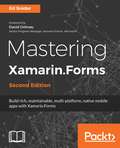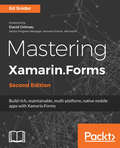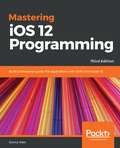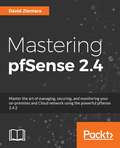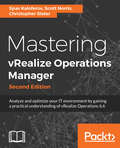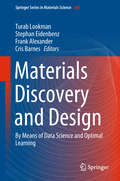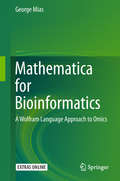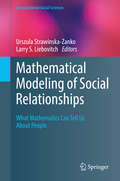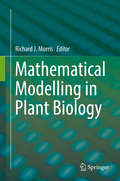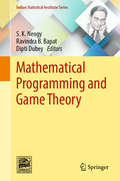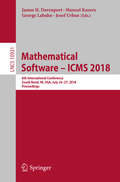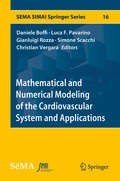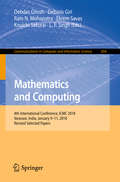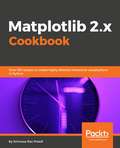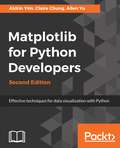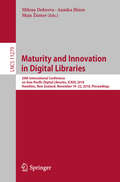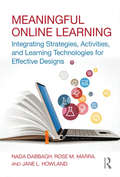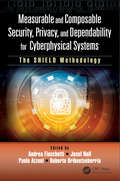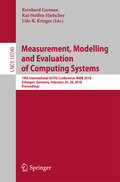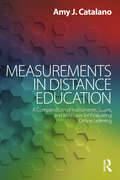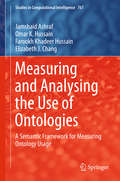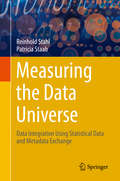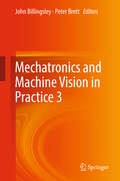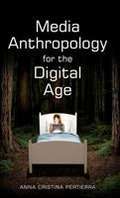- Table View
- List View
Mastering Xamarin.Forms.: Build Rich, Maintainable, Multi-platform, Native Mobile Apps With Xamarin. Forms
by Ed SniderDiscover how to extend and build upon the components of the Xamarin.Forms toolkit to develop an effective, robust mobile app architecture. Starting with an app built with the basics of the Xamarin.Forms toolkit, you'll go step by step through several advanced topics to create a solution architecture rich with the benefits of good design patterns and best practices.
Mastering Xamarin.Forms: Build rich, maintainable, multi-platform, native mobile apps with Xamarin.Forms, 2nd Edition
by Ed SniderCreate high-quality multi-platform native apps with Xamarin.FormsKey Features Packed with real-world scenarios and solutions to help you build professional-grade mobile apps with Xamarin.Forms Build an effective mobile app architecture with the Xamarin.Forms toolkit Find out how, when, and why you should use architectural patterns and get best practices with Xamarin.FormsBook DescriptionDiscover how to extend and build upon the components of the Xamarin.Forms toolkit to develop an effective, robust mobile app architecture. Starting with an app built with the basics of the Xamarin.Forms toolkit, you'll go step by step through several advanced topics to create a solution architecture rich with the benefits of good design patterns and best practices. You'll start by introducing a core separation between the app's user interface and its business logic by applying the MVVM pattern and data-binding. Then you focus on building out a layer of plugin-like services that handle platform-specific utilities such as navigation and geo-location, and on how to loosely use these services in the app with inversion of control and dependency injection. Next you connect the app to a live web-based API and set up offline synchronization. Then, you delve into testing the app logic through unit tests. Finally, you set up Visual Studio App Center for monitoring usage and bugs to gain a proactive edge on app quality.What you will learn Implement the Model-View-View-Model (MVVM) pattern and data-binding in Xamarin.Forms mobile apps Extend the Xamarin.Forms navigation API with a custom ViewModel-centric navigation service Leverage the inversion of control and dependency injection patterns in Xamarin.Forms mobile apps Work with online and offline data in Xamarin.Forms mobile apps Test business logic in Xamarin.Forms mobile apps Use platform-specific APIs to build rich custom user interfaces in Xamarin.Forms mobile apps Explore how to improve mobile app quality using Visual Studio AppCenterWho this book is forThis book is intended for C# developers who are familiar with the Xamarin platform and the Xamarin.Forms toolkit. If you have already started working with Xamarin.Forms and want to take your app to the next level with higher quality, maintainability, testability, and flexibility, then this book is for you.
Mastering iOS 12 Programming: Build professional-grade iOS applications with Swift and Xcode 10, 3rd Edition
by Donny WalsBecome a professional iOS developer with the most in-depth and advanced guide to Swift, Xcode 10, ARKit, and Core MLKey FeaturesExplore the extensive world of iOS development through practical examplesGain detailed insights into core iOS programming concepts such as app extensions and performanceExtend your iOS apps by adding augmented reality and machine learning capabilitiesBook DescriptionThe iOS development environment has significantly matured, and with Apple users spending more money in the App Store, there are plenty of development opportunities for professional iOS developers. However, the journey to mastering iOS development and the new features of iOS 12 is not straightforward. This book will help you make that transition smoothly and easily. With the help of Swift 4.2, you’ll not only learn how to program for iOS 12, but also how to write efficient, readable, and maintainable Swift code that maintains industry best practices. Mastering iOS 12 Programming will help you build real-world applications and reflect the real-world development flow. You will also find a mix of thorough background information and practical examples, teaching you how to start implementing your newly gained knowledge. By the end of this book, you will have got to grips with building iOS applications that harness advanced techniques and make best use of the latest and greatest features available in iOS 12.What you will learnBuild a professional iOS application using Xcode 10 and Swift 4.2Use AutoLayout to create complex layouts that look great on every deviceDelve into advanced animations with UIViewPropertyAnimator and UIKit DynamicsEnhance your app by using instruments and building your own profiling toolsIntegrate iMessage, Siri, and more in your app through app extensionsTrain and use machine learning models with Core ML 2 and Create MLCreate engaging augmented reality experiences with ARKit 2Who this book is forIf you’re a developer with some experience in iOS programming and want to enhance your skills by unlocking the full potential of the latest iOS version with Swift to build great applications, this book is for you.
Mastering pfSense,: Manage, secure, and monitor your on-premise and cloud network with pfSense 2.4, 2nd Edition
by David ZientaraInstall and configure a pfSense router/firewall, and become a pfSense expert in the process.Key FeaturesYou can always do more to secure your software – so extend and customize your pfSense firewallBuild a high availability security system that’s fault-tolerant – and capable of blocking potential threatsPut the principles of better security into practice by implementing examples provided in the textBook DescriptionpfSense has the same reliability and stability as even the most popular commercial firewall offerings on the market – but, like the very best open-source software, it doesn’t limit you. You’re in control – you can exploit and customize pfSense around your security needs.Mastering pfSense - Second Edition, covers features that have long been part of pfSense such as captive portal, VLANs, traffic shaping, VPNs, load balancing, Common Address Redundancy Protocol (CARP), multi-WAN, and routing. It also covers features that have been added with the release of 2.4, such as support for ZFS partitions and OpenVPN 2.4. This book takes into account the fact that, in order to support increased cryptographic loads, pfSense version 2.5 will require a CPU that supports AES-NI. The second edition of this book places more of an emphasis on the practical side of utilizing pfSense than the previous edition, and, as a result, more examples are provided which show in step-by-step fashion how to implement many features.What you will learnConfigure pfSense services such as DHCP, Dynamic DNS, captive portal, DNS, NTP and SNMPSet up a managed switch to work with VLANsUse pfSense to allow, block and deny traffic, and to implement Network Address Translation (NAT)Make use of the traffic shaper to lower and raise the priority of certain types of trafficSet up and connect to a VPN tunnel with pfSenseIncorporate redundancy and high availability by utilizing load balancing and the Common Address Redundancy Protocol (CARP)Explore diagnostic tools in pfSense to solve network problemsWho this book is forThis book is for those with at least an intermediate understanding of networking. Prior knowledge of pfSense would be helpful but is not required.Those who have the resources to set up a pfSense firewall, either in a real or virtual environment, will especially benefit, as they will be able to follow along with the examples in the book.
Mastering vRealize Operations Manager: Analyze and optimize your IT environment by gaining a practical understanding of vRealize Operations 6.6, 2nd Edition
by Scott Norris Spas Kaloferov Chris Slater Alasdair CarnieManage vRealize operations manager 6.6 effectively using this comprehensive guide.Key FeaturesGet complete control of capacity management in your virtual environmentDisplay the most appropriate performance metrics and assemble your own dashboardAnalyze and process data from different sources into a single repositoryOptimize vRealize Automation workload placement Book DescriptionIn the modern IT world, the criticality of managing the health, efficiency, and compliance of virtualized environments is more important than ever. With vRealize Operations Manager 6.6, you can make a difference to your business by being reactive rather than proactive.Mastering vRealize Operations Manager helps you streamline your processes and customize the environment to suit your needs. You will gain visibility across all devices in the network and retain full control. With easy-to-follow, step-by-step instructions and support images, you will quickly master the ability to manipulate your data and display it in a way that best suits you and your business or technical requirements. This book not only covers designing, installing, and upgrading vRealize Operations 6.6, but also gives you a deep understanding of its building blocks: badges, alerts, super metrics, views, dashboards, management packs, and plugins. With the new vRealize Operations 6.6 troubleshooting capabilities, capacity planning, intelligent workload placement, and additional monitoring capabilities, this book is aimed at ensuring you get the knowledge to manage your virtualized environment as effectively as possible.What you will learn Discover advanced vRealize Operations concepts and design your processes effectively for the underlying architecture Plan and install a new version or upgrade from a previous one Apply proven capacity management theories and techniques in practical, real-world environments Manipulate data and metrics to display them in the most effective way possible Create custom views and dashboards fit for any use case Explore how policies have evolved in vRealize Operations 6.6 and how to apply them in the most effective mannerWho this book is forIf you are an administrator of a virtual environment and have used vRealize Operations before but want to gain a professional understanding by easily implementing complex tasks with it, then this book is for you.
Materials Discovery and Design: By Means of Data Science and Optimal Learning (Springer Series in Materials Science #280)
by Turab Lookman Frank Alexander Stephan Eidenbenz Cris BarnesThis book addresses the current status, challenges and future directions of data-driven materials discovery and design. It presents the analysis and learning from data as a key theme in many science and cyber related applications. The challenging open questions as well as future directions in the application of data science to materials problems are sketched. Computational and experimental facilities today generate vast amounts of data at an unprecedented rate. The book gives guidance to discover new knowledge that enables materials innovation to address grand challenges in energy, environment and security, the clearer link needed between the data from these facilities and the theory and underlying science. The role of inference and optimization methods in distilling the data and constraining predictions using insights and results from theory is key to achieving the desired goals of real time analysis and feedback. Thus, the importance of this book lies in emphasizing that the full value of knowledge driven discovery using data can only be realized by integrating statistical and information sciences with materials science, which is increasingly dependent on high throughput and large scale computational and experimental data gathering efforts. This is especially the case as we enter a new era of big data in materials science with the planning of future experimental facilities such as the Linac Coherent Light Source at Stanford (LCLS-II), the European X-ray Free Electron Laser (EXFEL) and MaRIE (Matter Radiation in Extremes), the signature concept facility from Los Alamos National Laboratory. These facilities are expected to generate hundreds of terabytes to several petabytes of in situ spatially and temporally resolved data per sample. The questions that then arise include how we can learn from the data to accelerate the processing and analysis of reconstructed microstructure, rapidly map spatially resolved properties from high throughput data, devise diagnostics for pattern detection, and guide experiments towards desired targeted properties. The authors are an interdisciplinary group of leading experts who bring the excitement of the nascent and rapidly emerging field of materials informatics to the reader.
Mathematica for Bioinformatics: A Wolfram Language Approach To Omics
by George MiasThis book offers a comprehensive introduction to using Mathematica and the Wolfram Language for Bioinformatics. The chapters build gradually from basic concepts and the introduction of the Wolfram Language and coding paradigms in Mathematica, to detailed worked examples derived from typical research applications using Wolfram Language code. The coding examples range from basic sequence analysis, accessing genomic databases, differential gene expression, and machine learning implementations to time series analysis of longitudinal omics experiments, multi-omics integration and building dynamic interactive bioinformatics tools using the Wolfram Language. The topics address the daily bioinformatics needs of a broad audience: experimental users looking to understand and visualize their data, beginner bioinformaticians acquiring coding expertise in providing biological research solutions, and practicing expert bioinformaticians working on omics who wish to expand their toolset to include the Wolfram Language.
Mathematical Modeling of Social Relationships: What Mathematics Can Tell Us About People (Computational Social Sciences)
by Larry S. Liebovitch Urszula Strawinska-ZankoThis edited volume presents examples of social science research projects that employ new methods of quantitative analysis and mathematical modeling of social processes. This book presents the fascinating areas of empirical and theoretical investigations that use formal mathematics in a way that is accessible for individuals lacking extensive expertise but still desiring to expand their scope of research methodology and add to their data analysis toolbox. Mathematical Modeling of Social Relationships professes how mathematical modeling can help us understand the fundamental, compelling, and yet sometimes complicated concepts that arise in the social sciences. This volume will appeal to upper-level students and researchers in a broad area of fields within the social sciences, as well as the disciplines of social psychology, complex systems, and applied mathematics.
Mathematical Modelling in Plant Biology
by Richard J. MorrisProgress in plant biology relies on the quantification, analysis and mathematical modeling of data over different time and length scales. This book describes common mathematical and computational approaches as well as some carefully chosen case studies that demonstrate the use of these techniques to solve problems at the forefront of plant biology. Each chapter is written by an expert in field with the goal of conveying concepts whilst at the same time providing sufficient background and links to available software for readers to rapidly build their own models and run their own simulations. This book is aimed at postgraduate students and researchers working the field of plant systems biology and synthetic biology, but will also be a useful reference for anyone wanting to get into quantitative plant biology.
Mathematical Programming and Game Theory (Indian Statistical Institute Series)
by Ravindra B. Bapat S. K. Neogy Dipti DubeyThis book discusses recent developments in mathematical programming and game theory, and the application of several mathematical models to problems in finance, games, economics and graph theory. All contributing authors are eminent researchers in their respective fields, from across the world. This book contains a collection of selected papers presented at the 2017 Symposium on Mathematical Programming and Game Theory at New Delhi during 9–11 January 2017. Researchers, professionals and graduate students will find the book an essential resource for current work in mathematical programming, game theory and their applications in finance, economics and graph theory. The symposium provides a forum for new developments and applications of mathematical programming and game theory as well as an excellent opportunity to disseminate the latest major achievements and to explore new directions and perspectives.
Mathematical Software – ICMS 2018: 6th International Conference, South Bend, IN, USA, July 24-27, 2018, Proceedings (Lecture Notes in Computer Science #10931)
by James H. Davenport Manuel Kauers George Labahn Josef UrbanThis book constitutes the proceedings of the 6th International Conference on Mathematical Software, ICMS 2018, held in South Bend, IN, USA, in July 2018.The 59 papers included in this volume were carefully reviewed and selected from numerous submissions. The program of the 2018 meeting consisted of 20 topical sessions, each of which providing an overview of the challenges, achievements and progress in a subeld of mathematical software research, development and use.
Mathematical and Numerical Modeling of the Cardiovascular System and Applications (SEMA SIMAI Springer Series #16)
by Gianluigi Rozza Daniele Boffi Simone Scacchi Luca F. Pavarino Christian VergaraThe book comprises contributions by some of the most respected scientists in the field of mathematical modeling and numerical simulation of the human cardiocirculatory system. It covers a wide range of topics, from the assimilation of clinical data to the development of mathematical and computational models, including with parameters, as well as their efficient numerical solution, and both in-vivo and in-vitro validation. It also considers applications of relevant clinical interest. This book is intended for graduate students and researchers in the field of bioengineering, applied mathematics, computer, computational and data science, and medicine wishing to become involved in the highly fascinating task of modeling the cardiovascular system.
Mathematics Education in Brazil: Panorama of Current Research
by Alessandro Jacques Ribeiro Lulu Healy Rute Elizabete Borba Solange Hassan FernandesThis book presents, for the first time in English, the state of the art of Mathematics Education research in Brazil, a country that has the strongest community in this field in Latin America. Edited by leading researchers in the area, the volume provides the international academic community a summary of the scientific production of the thirteen working groups of the Brazilian Society of Mathematics Education (SBEM), the national scientific society that brings together researchers, teachers, students and other professionals of the area. These working groups meet every three years at the International Seminar of Mathematics Education (SIPEM) and cover the following topics: Mathematics Education in the Early Years and Primary Education (Y1-Y5); Mathematics Education in the Middle School (Y6-Y9); Mathematics Education in the High School (Y10-Y12); Mathematics Education at the University level; History of Mathematics, Culture and Mathematics Education; Digital Technologies and Distance Education; Teacher Education; Assessment and Mathematics Education; Cognitive and Linguistic Processes in Mathematics Education; Mathematical Modeling; Philosophy of Mathematics Education, Teaching Probability and Statistics; and Difference, Inclusion and Mathematics Education. Each chapter of the book presents an overview of the production of a working group and they are all preceded by an introduction by professor Ubiratan D’Ambrosio, one of the pioneers of Mathematics Education in Brazil.
Mathematics and Computing: Icmc, Haldia, India, January 2015 (Springer Proceedings In Mathematics And Statistics Series #139)
by Ram N. Mohapatra Debasis Giri Debdas Ghosh Ekrem Savas Kouichi Sakurai L. P. SinghThis book constitutes the proceedings of the 4th International Conference on Mathematics and Computing, ICMC 2018, held in Varanasi, India, in January 2018.The 29 papers presented in this volume were carefully reviewed and selected from 116 submissions. They are organized in topical sections on security and coding theory; computing; applied mathematics; pure mathematics.
Matplotlib 3.0 Cookbook: Over 150 recipes to create highly detailed interactive visualizations using Python
by Srinivasa Rao PoladiBuild attractive, insightful, and powerful visualizations to gain quality insights from your dataKey FeaturesMaster Matplotlib for data visualizationCustomize basic plots to make and deploy figures in cloud environmentsExplore recipes to design various data visualizations from simple bar charts to advanced 3D plotsBook DescriptionMatplotlib provides a large library of customizable plots, along with a comprehensive set of backends. Matplotlib 3.0 Cookbook is your hands-on guide to exploring the world of Matplotlib, and covers the most effective plotting packages for Python 3.7. With the help of this cookbook, you'll be able to tackle any problem you might come across while designing attractive, insightful data visualizations. With the help of over 150 recipes, you'll learn how to develop plots related to business intelligence, data science, and engineering disciplines with highly detailed visualizations. Once you've familiarized yourself with the fundamentals, you'll move on to developing professional dashboards with a wide variety of graphs and sophisticated grid layouts in 2D and 3D. You'll annotate and add rich text to the plots, enabling the creation of a business storyline. In addition to this, you'll learn how to save figures and animations in various formats for downstream deployment, followed by extending the functionality offered by various internal and third-party toolkits, such as axisartist, axes_grid, Cartopy, and Seaborn. By the end of this book, you'll be able to create high-quality customized plots and deploy them on the web and on supported GUI applications such as Tkinter, Qt 5, and wxPython by implementing real-world use cases and examples.What you will learnDevelop simple to advanced data visualizations in Matplotlib Use the pyplot API to quickly develop and deploy different plots Use object-oriented APIs for maximum flexibility with the customization of figuresDevelop interactive plots with animation and widgets Use maps for geographical plotting Enrich your visualizations using embedded texts and mathematical expressionsEmbed Matplotlib plots into other GUIs used for developing applicationsUse toolkits such as axisartist, axes_grid1, and cartopy to extend the base functionality of MatplotlibWho this book is forThe Matplotlib 3.0 Cookbook is for you if you are a data analyst, data scientist, or Python developer looking for quick recipes for a multitude of visualizations. This book is also for those who want to build variations of interactive visualizations.
Matplotlib for Python Developers: Effective techniques for data visualization with Python, 2nd Edition
by Allen Yu Claire Chung Aldrin YimLeverage the power of Matplotlib to visualize and understand your data more effectivelyKey FeaturesPerform effective data visualization with Matplotlib and get actionable insights from your dataDesign attractive graphs, charts, and 2D plots, and deploy them to the webGet the most out of Matplotlib in this practical guide with updated code and examplesBook DescriptionPython is a general-purpose programming language increasingly being used for data analysis and visualization. Matplotlib is a popular data visualization package in Python used to design effective plots and graphs. This is a practical, hands-on resource to help you visualize data with Python using the Matplotlib library. Matplotlib for Python Developers, Second Edition shows you how to create attractive graphs, charts, and plots using Matplotlib. You will also get a quick introduction to third-party packages, Seaborn, Pandas, Basemap, and Geopandas, and learn how to use them with Matplotlib. After that, you’ll embed and customize your plots in third-party tools such as GTK+3, Qt 5, and wxWidgets. You’ll also be able to tweak the look and feel of your visualization with the help of practical examples provided in this book. Further on, you’ll explore Matplotlib 2.1.x on the web, from a cloud-based platform using third-party packages such as Django. Finally, you will integrate interactive, real-time visualization techniques into your current workflow with the help of practical real-world examples.By the end of this book, you’ll be thoroughly comfortable with using the popular Python data visualization library Matplotlib 2.1.x and leveraging its power to build attractive, insightful, and powerful visualizations.What you will learnCreate 2D and 3D static plots such as bar charts, heat maps, and scatter plotsGet acquainted with GTK+3, Qt5, and wxWidgets to understand the UI backend of MatplotlibDevelop advanced static plots with third-party packages such as Pandas, GeoPandas, and SeabornCreate interactive plots with real-time updatesDevelop web-based, Matplotlib-powered graph visualizations with third-party packages such as DjangoWrite data visualization code that is readily expandable on the cloud platformWho this book is forThis book is essentially for anyone who wants to create intuitive data visualizations using the Matplotlib library. If you’re a data scientist or analyst and wish to create attractive visualizations using Python, you’ll find this book useful. Some knowledge of Python programming is all you need to get started.
Maturity and Innovation in Digital Libraries: 20th International Conference on Asia-Pacific Digital Libraries, ICADL 2018, Hamilton, New Zealand, November 19-22, 2018, Proceedings (Lecture Notes in Computer Science #11279)
by Milena Dobreva Annika Hinze Maja ŽumerThis book constitutes the refereed proceedings of the 20th International Conference on Asia-Pacific Digital Libraries, ICADL 2018, held in Hamilton, New Zealand, in November 2018. The 20 full, 6 short, and 11 work in progress papers presented in this volume were carefully reviewed and selected from 77 submissions. The papers were organized in topical sections named: topic modeling and semantic analysis; social media, web, and news; heritage and localization; user experience; digital library technology; and use cases and digital librarianship.
Meaningful Online Learning: Integrating Strategies, Activities, and Learning Technologies for Effective Designs
by Nada Dabbagh Jane L. Howland Rose M. MarraMeaningful Online Learning explores the design and facilitation of high-quality online learning experiences and outcomes through the integration of theory-based instructional strategies, learning activities, and proven educational technologies. Building on the authors’ years of synthesized research and expertise, this textbook prepares instructors in training to create, deliver, and evaluate learner-centered online pedagogies. Pre- and in-service K–12 teachers, higher education faculty, and instructional designers in private, corporate, or government settings will find a comprehensive approach and support system for their design efforts.
Measurable and Composable Security, Privacy, and Dependability for Cyberphysical Systems: The SHIELD Methodology
by Andrea Fiaschetti Josef Noll Paolo Azzoni Roberto UribeetxeberriaWith a business baseline focused on the impact of embedded systems in the years ahead, the book investigates the Security, Privacy and Dependability (SPD) requirements raised from existing and future IoT, Cyber-Physical and M2M systems. It proposes a new approach to embedded systems SPD, the SHIELD philosophy, that relies on an overlay approach to SPD, on a methodology for composable SPD, on the use of semantics, and on the design of embedded systems with built-in SPD. The book explores new ground and illustrates the development of approximately forty prototypes capable of managing and enhancing SPD, including secure boot, trusted execution environments, adaptable radio interfaces, and different implementations of the middleware for measuring and composing SPD.
Measurement, Modelling and Evaluation of Computing Systems: 19th International GI/ITG Conference, MMB 2018, Erlangen, Germany, February 26-28, 2018, Proceedings (Lecture Notes in Computer Science #10740)
by Reinhard German Kai-Steffen Hielscher Udo R. KriegerThis book constitutes the proceedings of the 19th International GI/ITG Conference on Measurement, Modelling and Evaluation of Computing Systems, MMB 2018, held in Erlangen, Germany, in February 2018. The 16 full papers, 4 PhD track papers, and 9 tool papers presented in this volume were carefully reviewed and selected from 42 submissions. They are dealing with performance and dependability evaluation techniques for computer and communication systems and its related fields.
Measurements in Distance Education: A Compendium of Instruments, Scales, and Measures for Evaluating Online Learning
by Amy J. CatalanoAs more postsecondary faculty become engaged in designing online learning environments, research conducted on distance education program quality becomes increasingly important. Measurements in Distance Education is a concise, well-organized guide to some of the many instruments, scales, and methods that have been created to assess distance education environments, learners, and teachers. Entries are organized according to the qualities these measures attempt to gauge—such as engagement and information retention—and provide summaries of each instrument, usage information, the history of its development, and validation, including any reported psychometric properties. Offering more than 50 different surveys, tests, and other metrics, this book is an essential reference for anyone interested in understanding distance education assessment.
Measuring and Analysing the Use of Ontologies: A Semantic Framework For Measuring Ontology Usage (Studies In Computational Intelligence #767)
by Elizabeth J. Chang Jamshaid Ashraf Omar K. Hussain Farookh Khadeer HussainThis unique book succinctly summarizes the need to measure how ontologies (one of the building blocks of the Semantic Web) are currently being utilized, providing insights for various stakeholders. Where possible it improves and reuses terms in existing vocabularies/ontologies, as recommended by the Linked Data community. Recent advances in the Semantic Web have led to a proliferation of Resource Description Framework (RDF) data, which employ ontologies to semantically describe the information on the Web making it equally understandable for both humans and machines. However, to create a network effect, it is important that selective ontologies are used by more data publishers to improve the value of that ontology. For this to happen, it is vital to discover what is being used from an ontology to semantically annotate the information on the Web specific to a given domain. Answers to such basic but crucial questions can only be achieved by ascertaining how ontologies in the current semantic web are being utilized and adopted. The proposed frameworks to obtain such insights are explained with real-world examples to provide a clear and detailed description of ontology usage analysis. Both theoretical and practical, the book is of value to academics and professionals working in industry. Specifically, it is of primary interest to researchers, graduate students and practitioners in the area of the Semantic Web and its various real-world applications.
Measuring the Data Universe: Data Integration Using The Statistical Data And Metadata Exchange
by Reinhold Stahl Patricia StaabThis richly illustrated book provides an easy-to-read introduction to the challenges of organizing and integrating modern data worlds, explaining the contribution of public statistics and the ISO standard SDMX (Statistical Data and Metadata Exchange). As such, it is a must for data experts as well those aspiring to become one.Today, exponentially growing data worlds are increasingly determining our professional and private lives. The rapid increase in the amount of globally available data, fueled by search engines and social networks but also by new technical possibilities such as Big Data, offers great opportunities. But whatever the undertaking – driving the block chain revolution or making smart phones even smarter – success will be determined by how well it is possible to integrate, i.e. to collect, link and evaluate, the required data. One crucial factor in this is the introduction of a cross-domain order system in combination with a standardization of the data structure. Using everyday examples, the authors show how the concepts of statistics provide the basis for the universal and standardized presentation of any kind of information. They also introduce the international statistics standard SDMX, describing the profound changes it has made possible and the related order system for the international statistics community.
Mechatronics and Machine Vision in Practice 3
by John Billingsley Peter BrettIn contrast with previous books on mechatronics and machine vision in practice, a significant number of chapters focus on systems designed for human interaction and deciphering human motion. Examples illustrate assistive actuation of hip joints, the augmentation of touch sense in artificial hand prostheses and helping stroke survivors in repetitive motion therapy. Interactive mechatronics and the experience of developing machine interfaces has enabled an examination of how we use mechatronics in the service of training, and even to consider why computer games perhaps appear to capture attention so much more readily than a human instructor! Mechatronics continues to be an exciting and developing field. It is now an essential part of our world and living experience. This and the previous books in this series illustrate the journey in developing the use of mechatronics so far. We anticipate that you will find the chapters here an equal source of inspiration for new devices to solve the challenges of new applications, and of course as a resource for teaching and inspiring the new generation of mechatronics engineers.
Media Anthropology for the Digital Age
by Anna PertierraThe field of anthropology took a long time to discover the significance of media in modern culture. In this important new book, Anna Pertierra tells the story of how a field - once firmly associated with the study of esoteric cultures - became a central part of the global study of media and communication. She recounts the rise of anthropological studies of media, the discovery of digital cultures, and the embrace of ethnographic methods by media scholars around the world. Bringing together longstanding debates in sociocultural anthropology with recent innovations in digital cultural research, this book explains how anthropology fits into the story and study of media in the contemporary world. It charts the mutual disinterest and subsequent love affair that has taken place between the fields of anthropology and media studies in order to understand how and why such a transformation has taken place. Moreover, the book shows how the theories and methods of anthropology offer valuable ways to study media from a ground-level perspective and to understand the human experience of media in the digital age. <p><p> Media Anthropology for the Digital Age will be of interest to students and scholars of media and communication, anthropology, and cultural studies, as well as anyone wanting to understand the use of anthropology across wider cultural debates.
